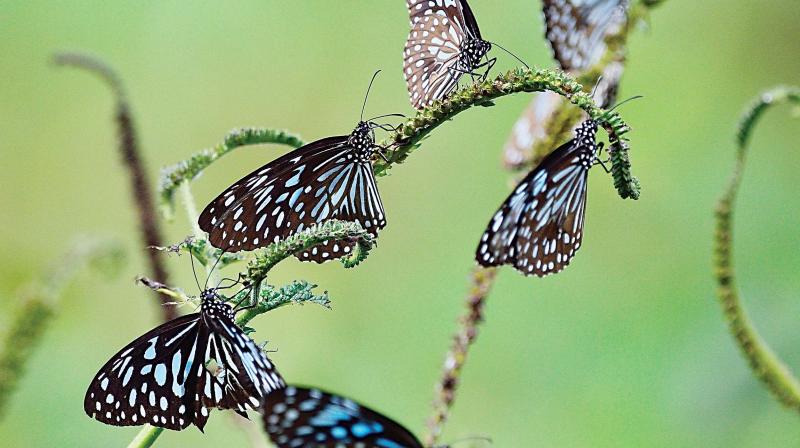Butterflies take Bengaluru by ‘swarm’
IT City witnesses wonderful spectacle of the winged beauties arriving in thousands while on the migratory route.

Bengaluru: Who doesn't love beautiful butterflies? These colourfully patterned winged mini beauties have fed the fantasies of poets and artists and offered metaphors for the more spiritually inclined. While many species are today facing a threat of extinction due to human- induced climate change, some Bengalureans have witnessed a "phenomenon" of sorts in the city of late, and have reported the sighting of swarms of butterflies in the sky.
"The last three days have been magical, particularly since Monday morning. As I was riding past Banashankari 6th stage, I saw a huge huge swarm of insects at a distance almost blocking the horizon. It reminded me of the scary locust swarms in the film, 'Ten Commandments.' The winged creatures were dark in colour. When curiosity took me closer, I realised it was a tsunami of butterflies, thousands of them. I have never seen so many beauties together before. On my way to Mysuru also I saw the same overwhelming scene in Ramanagara,” recounted Mr Prakash Murugan, a city businessman.
While he may be one of only a few to have seen such a spectacle in the city, going by a biodiversity educator it is not unusual to find swarms of butterflies in Bengaluru as it is a migratory passage for at least four varieties of young breeds.
"It's just that our people have become more observant these days due to an increasing interest in nature. For villagers, such sightings are not a surprise at all. But in an urban jungle like Bengaluru, they offer nothing short of a spectacle as not many are aware that it is a migratory passage for at least four varieties of young breeds of butterflies flying to the ghats," explained Mr. Madhusudhan Shukla, a biodiversity educator.
Although it’s not unusual to find blue and black butterflies fluttering around many homes in the city, most people don’t realise that these Dark Blue Tiger, Common Indian Crow and Double Banded Crow butterflies are actually in the process of migrating. "These three species of butterflies migrate together from the Western Ghats to the Eastern Ghats to escape the monsoon in June. After their long journey to the Eastern Ghats, most die after laying eggs. But once these eggs hatch and metamorphose into butterflies, the new winged beauties return to the Western Ghats in the months of September, October and November, " said Mr. Shukla.
The butterflies that fly 450 kms one way between the Western and Eastern Ghats draw from the energy of the sun to keep going , according to him. "Temperatures between 25 to 27 degree Celsius kind of convert the butterfly wings into solar panels. So you get to see the migration at its peak mid- morning when the sun is strong enough to energise the butterflies ,” he added.
But like human travellers, the butterflies too need stopovers to refuel. They, however, find few “dhabas” enroute when passing through a concrete jungle like Bengaluru. The solution could be butterfly gardening, Mr Shukla suggests.
"Butterflies look for nectar, and typically favour the flat, clustered flowers that provide a landing pad and abundant rewards. Unlike bees, butterflies can see red and make for brightly coloured red, yellow and orange flowers, that are ample nectar producers like Ixora, Pentas, Lantana and Balsam," he elaborated, adding that those interested in contributing to the conservation of butterflies, and moths should also opt for “caterpillar host plants” like Oleander, Gardenia, Zephranthes and Lime in their gardens.
While most adults in the city have not yet shown such concern for butterfly breeding, students of the Sri Kumaran Children’s Academy have already established a butterfly garden in Doddakallasandra. “Since then, these children have discovered the 'solar panel' phenomenon among butterflies,” the biodiversity educator informed with satisfaction. Such efforts may as yet be a drop in the ocean, but he believes they present hope for the survival of these tiny winged creatures that not only delight us by their existence, but also play an important role in conserving our biodiversity.
Said Mr Jalaluddin, a shopkeeper in Kaggadaspura, "I am glad the butterflies are here. Now the Ramphal tree in my garden will bear fruit as it is as good as barren without them." The little creatures are then beauties with a purpose, something that the “Garden City” may do well to remember.

